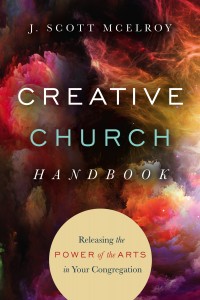Welcome to the online extras and resources for Chapter 5: Inspiring, Empowering and Leading Artists in the Church of The Creative Church Handbook. What you’ll find here is material that is helpful and important, but couldn’t be included in the book because of space constraints. Some thoughts include a reference to the specific page they would have appeared on.
For information and discussion on similar topics see The New Renaissance Arts Movement site at TheNewR.org. For questions, comments, or use permissions you may contact the author directly at Scott (at) TheNewR.org.
Visit our CreativeChurchArtsIdeas.org website for more ideas for creativity and arts ministry in the local church!
The page is under construction. Please check back for updates!
Chapter 5: Inspiring, Empowering and Leading Artists in the Church
“And whatever you do, whether in word or deed, do it all in the name of the Lord Jesus, giving thanks to God the Father through him.” Col 3:17 pg 80
If you took the advice in chapter four and circulated a survey in your first arts meeting, look over your surveys and see if people are excited to start specific groups for the arts such as writing, culinary, theater and so on.
Download the Arts Community Survey here.
- Thoughts from VIneArts Boise
When arts leaders (or any ministry leader) regularly seeks God’s direction for their ministry, taking time to wait and listen for his guidance, he will respond. You will be amazed at where he will lead you. Pg 76
The artists at VineArts Boise have recently begun to call each other their ‘art family.’ This family is a safe place where artists of all types can receive and heal and grow, enabling them to minister and serve the Lord from with their talents.” Pg 78
Thoughts from Nick Benoit
- Nick Benoit points out another facet of the artist’s call to listen and translate: responsibility. He says, “I think a lot of us treat inspiration with a high level of disregard. We will get an idea and allow it to fall by the wayside. The thing that I’ve learned is that, for me, I think so much of creativity is not about the inspiration but about the responsibility and courage that we must have to follow through with the inspiration and work we’ve been given. Because if we believe, as I do, that our creativity comes from God, and if he inspired us, who are we to let that fall away?” pg 79 Nick continues, “I have a journal; it’s called Day One on my iPad. I’m constantly writing little snippets of thoughts, because you get those moments of inspiration when you’re in traffic or while you’re in the shower. And then sometimes I will just look back through those snippets, choose one, and start whittling away on it. I think artists…hold onto inspiration and we say ‘I don’t have time for this’, but then the act of obedience is going back to it even when you don’t feel the inspiration anymore, and taking that little nugget, and turning it into something beautiful.This is part of walking out our calling, our destiny; just doing little things to move forward.” pg 86
- Nick also says that sometimes people who didn’t have the proper skills would come to audition for a production at Rock Harbor (his former church). Instead of turning them away, he would ask, “’What are the other kinds of things that you’re interested in?’, if this is not where their gifts lie. Because I truly believe that a lot of those people who have taken that step of bravery, to audition, or to raise their hand and say, ‘I’m interested in helping’, are brought to us for a reason. And God has prompted them to even take that first step. And so, I think it’s our role as pastors of creative people, to be personal with them to find out what they are uniquely made for, even though it might not be something that they’ve ever tried before.” Pg 88
- Pay attention to and journal the lessons and themes that God brings along to us personally, and pursue them. Pg 89

Goldsworthy’s artwork is site specific, using natural materials from that location. Many of his
sculptures are temporary and use things like ice, leaves, twigs or rocks, and are featured in the
documentary Rivers and Tides. Photo: Phil Roeder/Flickr/Creative Commons. License information available at
https://creativecommons.org/licenses/by/2.0.
Thoughts from Ann Williams of Lincoln Berean Church
- Lincoln Berean has a strong culture of serving and volunteering. Ann Williams says, “I think that’s one thing that is unique at our church. People who volunteer or serve are seeking what it is that God has for them. And they are on their knees and praying. So when you ask them you do trust that they are doing their part to seek God.” Pg 96
- Ann talks about the process of choosing arts leaders, “I watched a handful of participants show up again and again for art endeavors, and I waited a full year. When the time seemed right, I asked seven individuals to pray about being on my arts leadership team, and they were touched and honored. Our specific job descriptions have shifted organically as our ministry evolves, but I try to place my team leaders in areas where they can be the most fulfilled. Of course this takes a lot of communication between my team members and me, usually over coffee. pg 96 One of the people I asked two years ago to be on the team seemed to be a good fit. I asked and she said no. Two years later, I asked again and she said yes. She told me, ‘When you asked me the first time I wasn’t in a place where I was ready to do that. God had to humble me a little bit and bring me to where I was willing to serve.” So pg 96
- Ann talks about failures that came from not building a team to lead arts ministry: The failures are all learning times. Because things kind of fell by the wayside, even with the visual arts, the number of people serving dropped dramatically. Some of it was because a lot of those people experienced that they were the only ones doing it. They were the only ones passionate about it, they were the only ones putting in the hours and they were doing things by themselves and not building a team. So they got burned out, or a life circumstance would arise and they just fell off, and there was nobody to take their place. So we learned to build a team and work together.
Lynn Westergen talks about being an arts leader:
I honestly think God would be perfectly happy with me if I rarely left the studio and created a vast body of thoughtful work, loved my neighbors and the merchants I bought materials from etc….but, that will probably never be my lot. Even as I describe this solitary, if productive, life that I sometimes dream of, I know I wouldn’t be satisfied with that either.
Thoughts from Luann Jennings of CAELA
“Some of the “gaps” in natural ability can be filled through education. How? Read a book. Follow a blog. Take a class. Go to a conference. Buy a journal. Use it. Buy new software. Use it. Practice, practice, practice.” http://churchandart.org/2011/06/15/leaders-learn/
Luann Jennings talks about asking the right people for help, “Friends and family aren’t necessarily the people we should ask to design the costumes, play the trumpet solo, or write the grants. Other artists aren’t necessarily the people we should ask to give us money, bring us dinner, or listen to us vent.” Pg 97


